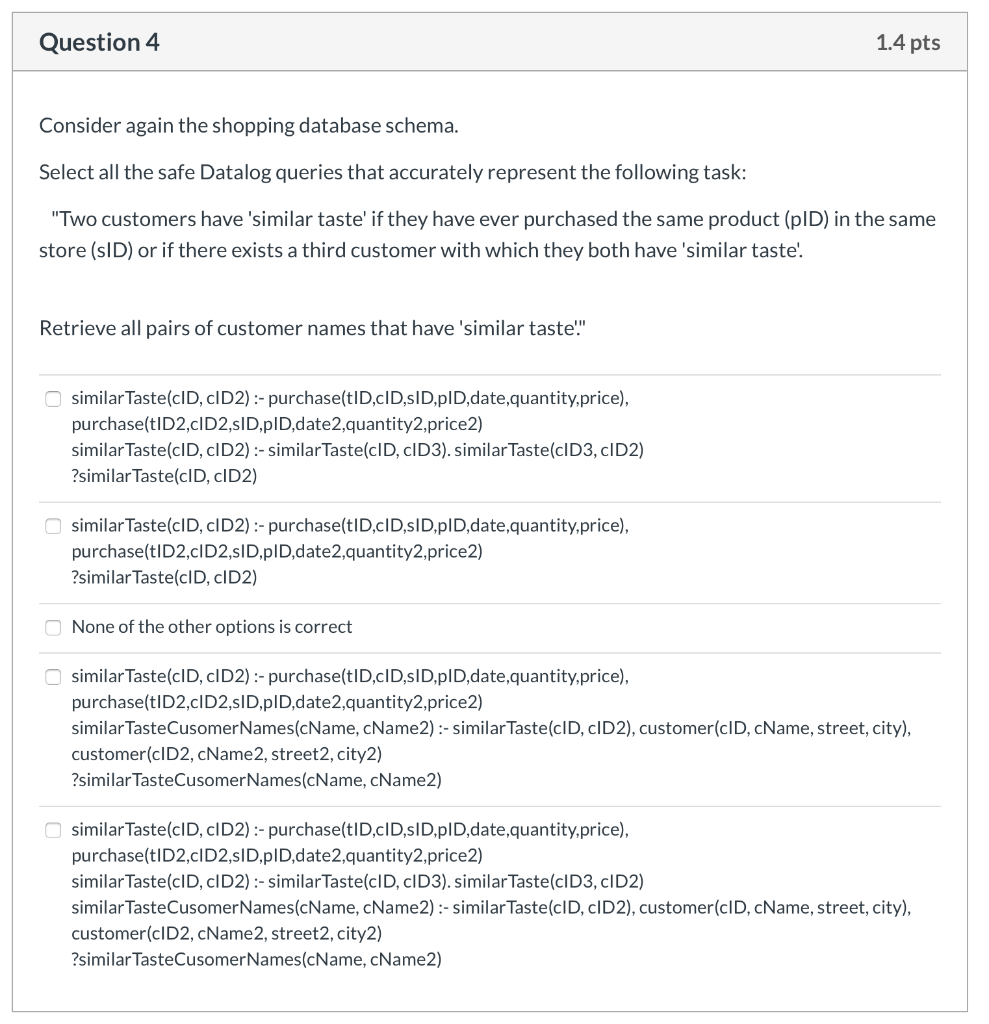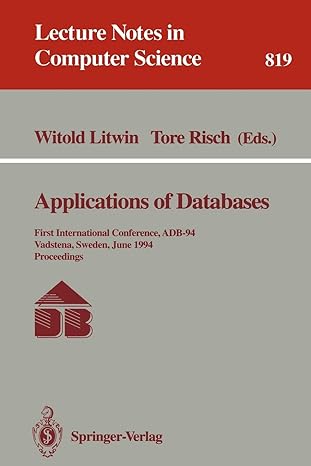Question
the shopping database For many query questions we refer to the following database schema for a website that keeps track of what people like to

the shopping database
For many query questions we refer to the following database schema for a website that keeps track of what people like to buy or actually buy in different on-line supermarkets. (Think of something like a cross-store loyalty card system.)
customer(cID, cName, street, city)
Customers with unique cID and other attributes
store(sID, sName, street, city)
Stores with a unique ID and other attributes. Stores with the same name but different sID (and address) form what we call a store chain.
product(pID, pName, suffix)
Products with a unique ID
shoppinglist(cID, pID, quantity, date)
What a customer wants to buy on a certain date. (Every customer creates at most one shoppinglist per day.)
purchase(tID, cID, sID, pID, date, quantity, price)
A transaction: what a customer bought in one go; every transaction (tID) corresponds to one customer (cID) buying from one store (sID) on one date (date); at some point during the course we see that this actually means tID cID,sID,date
inventory(sID, pID, date, quantity, unitPrice)
Inventory of a store as published at the start of a date.
Primary key attributes are underlined. (Foreign keys are not indicated but can be inferred from the attribute names that have been used.)
- The interpretation of the schema is as follows: Customers and stores should be pretty obvious.
- Products have a unique id and name but also some textual suffix that can indicate a content (weight in gram or content in liter, or size such as large, medium, small, etc. we do not "interpret" this suffix).
- A customer may wish to buy products on a certain date. The shoppinglist contains each product only once, with a quantity (how many "units" of the product to buy.)
- A customer then goes to an on-line store to buy some products. (The address of the store is only important for goods pick-up.) Such a purchase constitutes a transaction (hence tID). In a purchase a customer is at one store on one date and buys a number of products in a certain quantity and pays a price for that product (and quantity). It's like the "receipt" from the purchase. Each product is listed only once on that receipt.
- Each supermarket has inventory. For each product it has a number of units (quantity) in stock at the start of a certain date, and each product has a unit price. (We do not keep track of discounts that may lower the total price when buying several items in a single purchase.)
The database is "complete" (closed world assumption): we do not consider anything that may exist outside the database (like people who are not a customer or products that nobody wants and no store sells).
All customers appear in customer, all products in product and all stores in store. A store name that appears only once does not constitute a store chain. A store chain requires the existence of at least two stores with the same name.
When a store carries (sells) a product it may temporarily have an inventory quantity of 0 (meaning the product is out of stock). The product is then not removed from inventory. It is possible that there are several products (different pID) with the same pName and suffix, due to different identification schemes.
Although the true inventory changes constantly during the day the published inventory is only updated once, at the start of the day. (At some point during the course we start dealing with this issue.)
Question 4 1.4 pts Consider again the shopping database schema. Select all the safe Datalog queries that accurately represent the following task: "Two customers have 'similar taste' if they have ever purchased the same product (pID) in the same store (sID) or if there exists a third customer with which they both have 'similar taste! Retrieve all pairs of customer names that have similar taste!" similar Taste(cID, ID2) :- purchase(tID,CID,sID,pID,date,quantity,price), purchase(tID2,c1D2,sID,PID,date2,quantity2 price2) similar Taste(cID, ID2) :- similar Taste(cID, ID3). similar Taste(cID3, cID2) ?similar Taste(cID, ID2) similar Taste(CID, CID2) :- purchase(tID cID,SID,pD,date, quantity,price), purchase(tID2,cID2,sID,pID,date, quantity2,price2) ?similar Taste(cID, ID2) None of the other options is correct similar Taste(cID, ID2):- purchase(tID,cID,sIDpID,date,quantity,price), purchase(tID2,c1D2,sID,pID,date2, quantity2, price2) similar TasteCusomerNames(cName, cName2) :- similar Taste(CID, CID2), customer(cID, Name, street, city), customer(cID2, cName2, street2, city2) ?similar Taste CusomerNames(cName, cName2) similar Taste(cID, ID2) :- purchase(tIDcID,sID,pID,date,quantity,price), purchase(tID2,cD2,sID,pID,date2, quantity2, price2) similar Taste(cID, CID2) :- similar Taste(cID, ID3). similar Taste(clD3, c/D2) similar TasteCusomerNames(cName, cName2):- similar Taste(cID, ID2), customer(cID, Name, street, city), customer(CID2, cName2, street2, city2) ?similar TasteCusomerNames(cName, cName2)Step by Step Solution
There are 3 Steps involved in it
Step: 1

Get Instant Access to Expert-Tailored Solutions
See step-by-step solutions with expert insights and AI powered tools for academic success
Step: 2

Step: 3

Ace Your Homework with AI
Get the answers you need in no time with our AI-driven, step-by-step assistance
Get Started


